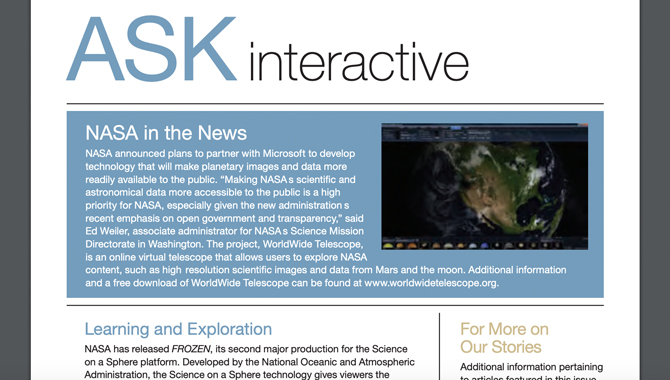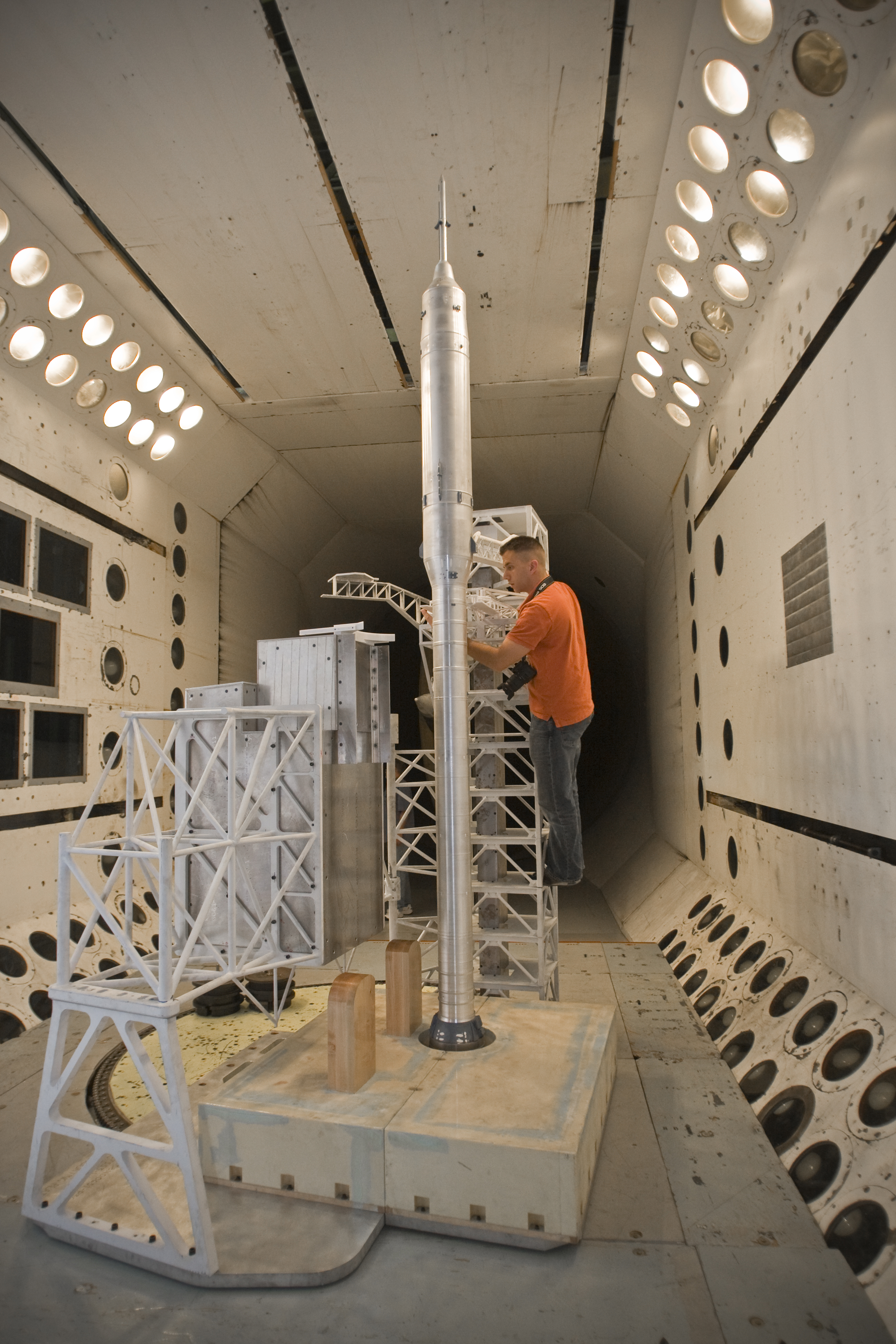
By Andrew Chaikin
When I was five, in 1961, one of my favorite books was called You Will Go to the Moon. It tells of a young boy who accompanies a team of astronauts on a lunar voyage. (How he gets to do this is never explained.) After landing at a lunar base, they put on space suits and go bounding across a bright, cratered moonscape. At the end of the story, they climb to the top of a tall hill and look into the starry sky, where they spot Mars, beckoning them still farther into space. “Mars is a long, long way from the moon,” says the narrator. “What would you find on Mars? No one knows yet. But someday you may go there, too! Then YOU will see.”

This Mars Global Surveyor Mars Orbiter Camera image shows a suite of south mid-latitude gullies on a crater wall that may have been formed by runoff of liquid water.
Photo Credit: NASA/JPL/
Malin Space Science Systems
As much as I wanted to believe the promise, “you will go to the moon,” I’m still waiting for my chance. And no one has been to Mars, which shines like a beacon on a dark and distant shore, awaiting the first footsteps of human beings. But I’m not complaining. I feel incredibly fortunate to have witnessed one of the most compelling sagas of the Space Age: the transformation of the red planet from a vague apparition in astronomers’ telescopes into a world brimming with wonders and mysteries. I even got to take part in that adventure as an undergraduate intern at the Jet Propulsion Laboratory (JPL) on the first Viking landing in 1976. Since then, I’ve covered Mars exploration as a science journalist, and the red planet has lost none of its allure. For my book, A Passion for Mars, I talked to some of the people who have been the driving force behind this epic quest. What they told me includes
Check your hubris at the door. From the surprisingly moonlike surface seen in Mariner 4’s first crude close-ups of the planet in 1965 to the geologic wonderland unveiled by the Mariner 9 orbiter in 1972, Mars has surprised scientists every time they’ve been able to see it in new detail. That was especially true for Caltech geologist Bruce Murray, who served as a junior member of the Mariner 4 science team and went on to become one of the leading experts on Martian geology. After three flyby missions showed a cratered, apparently unevolved landscape, Murray was not prepared for the world revealed by Mariner 9’s orbital survey, brimming with giant volcanoes, vast canyons, and ancient dry river valleys. And the surprises didn’t end there; they continued with every new mission. Three decades later, a new orbiter called Mars Global Surveyor, outfitted with a high-powered camera designed by Murray’s former student Mike Malin, was sending back spectacularly detailed views that revealed a host of baffling new surprises. By 2001 Murray was calling Mars “the land of broken paradigms.” If there is one thing Mars teaches us, it is that when we think we have it all figured out, we’d better think again.
Learn to be comfortable with ambiguity. One of the reasons Mars has held such a powerful grip on the human imagination is the enduring question of whether it harbors some form of life. But even after more than forty years of exploration by spacecraft, the answer remains elusive. In 1976 the twin Viking landers arrived on Mars carrying a trio of experiments designed to search for microbial life, but the data they sent back suggested not life but a surprisingly exotic surface chemistry laden with highly reactive compounds called peroxides. Meanwhile, an onboard gas chromatograph/mass spectrometer failed to detect organic molecules at a parts-per-billion level, suggesting that the very dust of Mars is hostile to life. In the end, the Viking results failed to settle the life-on-Mars question one way or the other, much to the chagrin of many journalists covering the mission.
And yet, to the media and the public at large, Viking’s failure to detect life was translated into a certainty that Mars is a dead planet. And so things stood for twenty years, until a team of NASA scientists claimed to have found evidence for fossil bacteria inside a Martian meteorite. That claim has remained controversial, but the ensuing discussions had the effect of dragging the entire subject of exobiology from the fringe to the mainstream. And more recently, evidence that water may flow beneath the surface today in subterranean aquifers has raised anew the possibility of Martian biology. True resolution of the question may not be had until astronauts go to Mars to conduct detailed on-site explorations. Until then, we can all take our cue from what Carl Sagan told frustrated members of the press late in the Viking mission: “What I would urge on you is an increased tolerance for ambiguity.”

Top: This Sojourner image, taken on Sol 70, shows rocks and rover-disturbed soil. The large rock in the distance is “Yogi.” Much of Yogi visible in this image cannot be seen from the perspective of the Pathfinder lander.
Bottom: The true color of Mars as seen by Pathfinder.
Photo Credits: NASA/JPL
Be prepared to go against the flow. In the mid-1980s, geologist Malin faced resistance from his colleagues when he proposed an extremely powerful camera for an upcoming Mars orbiter; the other scientists claimed they already had all the pictures of Mars they would ever need. Malin was convinced that an unknown Mars lurked below the limits of resolution, and after winning approval from NASA, he led the development of a lightweight, low-cost instrument called the Mars Observer Camera (MOC) that went to Mars aboard the ill-fated Mars Observer, which was lost shortly before entering Mars orbit in 1993. Malin had to wait another four years before a second MOC finally reached Mars aboard Mars Global Surveyor in 1997. And, just as he’d hoped, his camera discovered a Mars no one expected, where entire landscapes have been buried and exhumed over billions of years; where strange formations defy explanation; where climate change is now apparently under way. It is a world of ancient lake deposits and fossil river deltas, where signs exist that water has flowed across the surface in the recent geologic past—and, perhaps, even today. Malin is just one of countless Mars explorers who challenged conventional wisdom and were rewarded with spectacular discoveries.
Do the right thing. Exploring Mars is at the very edge of what we humans know how to do, and each new mission has tested our ingenuity. From 1968 to 1976 engineer Gentry Lee helped lead the engineering effort behind the billion-dollar Viking mission. Engineers were charged with developing an onboard computer to steer the landers to a soft touchdown, a biology package with three separate experiments crammed into a one-foot cube, and countless other cutting-edge components. To make everything more difficult, NASA required that the spacecraft undergo a grueling heat sterilization process before launch, in order to avoid bringing terrestrial bacteria to Mars. Seeing these challenges solved—and seeing the first pictures from the surface of Mars while helping to direct the mission at JPL—made Viking a high point in Lee’s life. He came out of that experience with an understanding of what it takes to do cutting-edge exploration, as exemplified by the hard-as-nails Viking project manager, Jim Martin. In Lee’s words, Martin practiced “an absolutely ruthless technical Darwinism. If you were not capable of doing your job, you were gone.”
A quarter-century later, in 2001, Lee returned to JPL to help oversee the young engineers working to create the Mars Exploration Rovers Spirit and Opportunity. The landing system for the rovers was nothing like Viking’s; they would “bump down” onto Mars cushioned by a set of giant airbags, just as the Mars Pathfinder lander had in 1997. But the rover teams struggled as they tried to adapt the Pathfinder system to the larger and more massive rovers. In testing, there was one technical showstopper after another, from failed parachutes to shredded airbags. Meanwhile, Lee and other Mars veterans subjected the young engineers to harsh reviews, threatening the project with cancellation. The team responded by digging in to redesign the parachute and the airbags; then, just months before launch, they created a system of small, computer-controlled rockets to counteract the Martian winds during the final descent. Even after the rovers were safely on Mars, the crises didn’t end; most harrowing was Spirit’s temporary loss of sanity due to computer problems just days before Opportunity was due to land. But each time, the teams stepped up with the same commitment, walking the high wire between success and failure, and saving the mission. In the end, Lee says, “The whole story [of the Mars Exploration Rovers] is one of heroism, where people would not accept the risks of not changing something and would accept the risk of the hours and hours of new work that would have to be done in order to make it right.”
Be in it for the long haul. Mars explorers must be driven to accomplish their goals, but they must also be willing to endure delays and disappointments. Cornell planetary scientist Steve Squyres spent ten years having his proposals for Mars missions rejected by NASA before his instruments were finally chosen for the mission that eventually became the Mars Exploration Rovers. That decade-long ordeal, Squyres told me, was far worse than the stress of actually creating the rovers and getting them ready in time for their 2003 launch window.
But no one epitomized this essential mix of patience and determination more than NASA Administrator Tom Paine, who was at the Agency’s helm during the first Apollo lunar landings. Even as Neil Armstrong and Buzz Aldrin took the first footsteps on the moon in July 1969, Paine hoped to convince President Richard Nixon to support an onward-and-upward space program, culminating in human expeditions to the red planet. It wasn’t just NASA that Paine wanted to advance; it was the human race. He believed space exploration had the power to transform civilization, not just with new technologies to improve life on Earth, but by giving humans the ability to settle other worlds. He wrote passionately about our future in space, of new branches of humanity taking root on alien shores in a renewal of the pioneer spirit of the American West. But Nixon and his people weren’t interested, and the hope of human Mars missions was squelched indefinitely. In the summer of 1970, as the White House continued to slash the space budget, Paine left NASA and returned to private life.

This false-color image taken by the Mars Exploration Rover Opportunity’s panoramic camera shows that dune crests have accumulated more dust than the flanks of the dunes and the flat surfaces between them.
Photo Credit: NASA/JPL/Cornell
Paine’s Martian dreams never left him, and in 1984 he met up with a group of young people determined to put Mars on NASA’s agenda, including several former grad students from the University of Colorado at Boulder. At a time when Mars wasn’t even on NASA’s radar screen, these young visionaries were trying to tackle the daunting obstacles to a Mars voyage, from keeping Mars-bound astronauts safe from solar flare radiation, to growing crops in a greenhouse on Mars, to obtaining rocket fuel from Martian resources. For the next decade Paine worked to help them, speaking at their conferences, writing papers, and adding his voice of experience to their efforts. Paine understood that the quest for Mars requires a commitment that spans generations, one in which you may not live to see your efforts bear fruit. He died in 1992; a chapter for the “Case for Mars” proceedings volume Strategies for Mars was the last thing he ever wrote.
Passion: Don’t leave home without it. It’s what Squyres talked about when I interviewed him in the spring of 2004, a few months after Spirit and Opportunity reached Mars. “Every one of us who participates in a mission like this feels an incredible passion for what we do,” Squyres told me. “That’s what got us to the launchpad. It was that passion.”
When I think of the passion for Mars, I think of the great science fiction writer Ray Bradbury, who has called Mars a way station on humanity’s journey toward immortality as an interstellar species. I think of Apollo 11 astronaut Mike Collins, who says the desire to journey to the red planet is part of “a primal urge to go outward bound …. A desire for what is next, what’s farther away, what we have not been to. Outward bound. And I don’t mean to get the photographs back; I mean to actually be there. To see, to touch, to smell, to die, to live there.”
And I think of my college geology professor, Tim Mutch, who led the Viking lander imaging team that obtained the first pictures from the surface of Mars. Mutch, who was also a mountaineer, and who was killed during a Himalayan climb in 1980, once likened Viking to climbing Mount Everest: “There’s a slim chance you’ll make it,” he told one interviewer, “but if you do, success is unequivocal!” Going to Mars ourselves, following in the footsteps of our robotic avatars, will be an Everest for the entire human species. And when we do, the reward will come not just from getting there, but who we become along the way: True to our nature as explorers and discoverers, harnessing our ingenuity to move all of humanity forward. No matter what we find on Mars, as Mutch once said, “The quest is the fundamental thing.”











